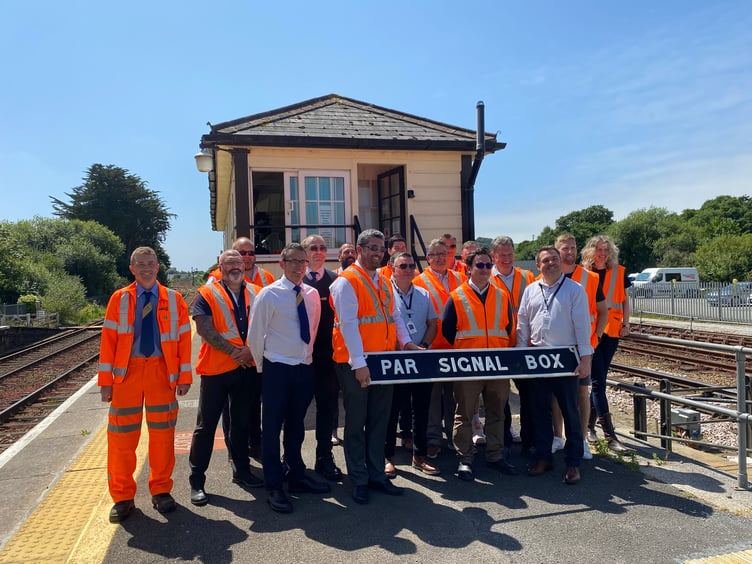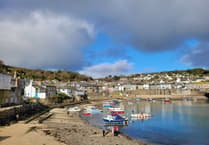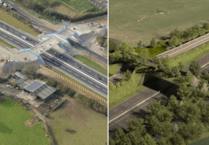Entering the signal box on platform 2 at Par railway station is to step back in time. With its 56 multicoloured levers, dials and bells, you might imagine that the signalman has just popped out for a smoke.
That’s the idea, anyway. The box closed on March 4; a poignant sign in the window declares: “And the bells fell silent…Par signalbox consigned to the history books.”
Many of the tools here, from lineside kit to semaphore signals and track circuit, are reaching the end of their design life. Signal boxes in Lostwithiel and Truro have also closed as part of a major project to switch to digital signalling from Exeter St David’s – from the pull of a lever to the click of a mouse.
However, that’s not the end of the story in Par. As manual signalling is likely to continue elsewhere in Cornwall for a decade or more, this Grade II-listed building will live on as a “sandpit” training facility, so-called because it allows workers to get hands-on in a safe environment.
On Thursday, the platform was a sea of orange as keys were handed over to local staff in what turned out to be a surprisingly emotional ceremony. Engineers, operations specialists and former signallers gathered to see the box into the next phase of its life, and shared fond memories of their own time within its walls.
The signal box first opened its doors in 1879, and it’s estimated that in 145 years of service, 1.5-million trains have whizzed past its windows. Martin Duff, a signaller who has worked extensively on the switchover project, explains: “The job of a signaller is to regulate traffic according to the timetable, and make best endeavours when running late to minimise or mitigate delays.”
He and Derek Buist, a former signaller and now Network Rail operations manager for West Country South, offer a demonstration of the kind of action that would be going on in here. Levers are numbered and coloured according to their roles – red works the signals; black works the points and blue locks them; black and blue does a combination of the two. Yellow, meanwhile, activates distant signals to give drivers advance warning of stop signals ahead. Many levers are pulled down in combinations to enable specific functions.
The bells work like Morse code, and mean things like: “Send a train”; “Don’t send a train”; “The line is clear”; and so on. Martin and Derek make it seem easy, but I’d be lying if I said I knew what it all meant. I’m just grateful they do, as their work has contributed to keeping millions of passengers on time and, crucially, safe.
At its most dramatic, signalling could prevent damage, serious injury or death in an emergency situation, which is why operatives spend four to six weeks familiarising themselves with the way things work, at all times of day (including night shifts), busy or quiet, before undergoing assessment.
Derek recalls “mammoth shifts” in this small space. “The levers are heavy, and pulling them in and out, in and out all day was quite a task – there’s a technique,” he says.
All agree that the box has its own “character” and could be “temperamental” at times. “You could work here all your career, come in one day and it would do something it’s never done before,” says Martin, rolling his eyes.
“The mainline could be closed if a lever didn’t work,” says Derek, with a knowing glance at number 36. And with all that metal around, temperature was a killer. Who hasn’t been late for work due to railway points expanding on a hot summer’s day?
“When things went wrong, you had to signal your way out of it,” says John Kelly, operations risk adviser for Network Rail and resident signaller in Par from 2002 to 2014. “If need be, you would open a window and call one of the S&T guys to come over, at a huge cost in tea and biscuits.”
Paul Gardiner was one of those S&T – signalling and telecoms – guys, covering 100 miles of track from Penzance to Totnes from the central location of Par. “Because this was our base, we had a real bond with the signallers here,” he says.
Paul joined the S&T gang as an apprentice at 18, 37 years ago when the signals were lit by paraffin lamps. “Back then, the older men in the box would have worked through the days of steam and early diesel,” he remembers.
The signalmen kept a spotless box, cleaning it on Sunday mornings when traffic was less busy. “I can still smell the wax polish and Brasso,” says Paul, recalling how trackside workers were strictly prohibited from sullying the shiny floor with their muddy, oily boots, and ordered to walk across the lever frame instead.
Outside, it’s a normal day. Trains pass through – a driver sticks her head out of the door to banter with her platform colleagues, who point out to me that she’s on the “wrong side of the tracks” – remote signalling has enabled trains to come in on any platform.
Occasionally, freight trains rattle in and out, destined for the china clay industry; but, to paraphrase the Jethro joke, “goods train don’t come through Thursday” so we won’t be seeing one today.
Martin remembers how the line between Burngullow and Probus was taken down to single track from the 1980s until 2004. “Had it been successful, it would have been rolled out further as an economy measure,” he says.
On the contrary, it created a bottleneck, with late-running services preventing anything leaving Truro and thus causing havoc.
“Thankfully it was reversed, as it would have worked against all today’s schemes, like the half-hourly service and the Mid-Cornwall Metro,” says Martin.
While the signal box at Lostwithiel is also listed and currently in search of a community use, Truro was not listed and is being stripped of its parts to be used as strategic spares, which are in short supply – a key reason why signalling is changing.
Back in Par, the mood is jovial. Craig Munday, who trained here in the early 2000s and acted as a relief signaller in other Cornish signal boxes, points out the original GWR toilet roll holder in the smallest room: “Don’t tell anyone, it’s highly desirable,” he winks.
A keen railway photographer, Craig is looking forward to the next visit of the Royal Duchy steam locomotive on July 28, which ends in Par and turns around using the turntable in nearby St Blazey.
“Par was my favourite signal box,” he muses. “You were out of the public eye, and every type of signalling rule was practised here – you could split trains, join them, run them in sections, take an engine from one end to the other.
“And it was the most delightful place to work. The sun rose on one side and set on the other, and geese would fly overhead – it was busy, but bucolic.”
John Kelly shares his evident affection for this small but characterful building. “I never enjoyed working anywhere else as much as I did Par,” he says. “This little box had a spirit of its own, and it looked after you.”





Comments
This article has no comments yet. Be the first to leave a comment.